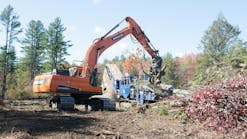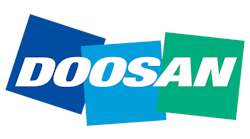Less than five years ago, Tim Lewis, then the senior director of construction equipment for Qualcomm Inc., was marketing GPSs to the construction industry as critical “management tools” for tracking and monitoring, predicting that within the next four years they would be standard. “It’s a matter of controlling operational efficiencies,” Lewis said at the time.
Case Construction had already introduced Fleetlink, which Marketing Manager John Marshall, billed as a “flight recorder” for construction equipment and Caterpillar was promising “maximum uptime, minimum repair costs,” with Product Link, which, it assured potential customers, would tell them everything they wanted to know about their equipment and more.
The Internet, especially paired with wireless communication, has in the years since made it easier for contractors to manage their equipment. Cigarette-pack-sized GPS units are installed on heavy equipment and fleet vehicles, data are communicated via cell phone or satellite, and customers access information through a password-secure Web site. For $500 to $1,000 per machine and a per-unit monthly access fee, an equipment manager can establish the individual whereabouts of company assets and track hours of operation. With add-ons, he can monitor critical details of machine function and performance. But have contractors embraced this opportunity, and are they using systems as the technology wizards originally imagined?
The answer is an equivocal [ITALIC]yes[ITALIC] and [ITALIC]no[ITALIC]. Original equipment manufacturers—such as Cat, Case and John Deere (which has since partnered with Qualcomm to market JDLink)—promise optimal maintenance, extended equipment life, maximum uptime, and reduced loss from theft and unauthorized use. Contractors managing large fleets of heavy equipment seem to be the first to have picked up on these opportunities, while smaller companies appear to be satisfied with theft protection and tracking hours for maintenance. In some instances, contractors are beginning to visualize the big picture, as Mike Baker, now senior director of national sales for Qualcomm Enterprise Services, describes it. In any case, applying these management systems has not been without challenges.
GPS North America sells a range of GPS-based solutions, from hardwired equipment locators to units that can provide a full record of equipment performance to its newest option, a portable battery-operated GPS tracker. But company president Todd Lewis estimates that only 10% of the construction market has opted for GPS for equipment management, “in spite of the fact that we can demonstrate it actually costs more money to do nothing—and not to mention what they’ll save on employee payroll hours and vehicle expenses.”
Likewise, Longview Advantage President Bill Quinney says his company has tried to keep the process as simple as possible. “We’ve focused on being able to protect assets from theft and sharing meter information with equipment owners for oil-change maintenance. And while we can do a lot more, we’ve found that for 95% of the market this is all the information they want. We’ve also determined that in the construction industry decision-making more often that not boils down to whether it’s more productive to know the location of your equipment or buy two additional machines.”
None of this deters Lee Knight, president of XacTrac, who argues that profitability is a direct function of sound asset management. “Knowing where your equipment is—right, now, last week, last month—not only helps you manage it more efficiently for greater revenues but also reduces expenses. To make money, you need billable hours, which means you need to keep your equipment busy.
“When we talk to people about GPS tracking, they’ll tell us the dispatcher knows where the equipment is, which is what in our company we call a mobile-bus-terminated design, meaning that if the dispatcher gets hit by a bus, they’ll have no clue where anything is. One day I was out driving jobs with a customer when we accidentally ran into an excavator he’d been looking for for two weeks. I asked him how much money he lost by not knowing where that piece of equipment was—and how about having to rent a piece of equipment to replace the one he couldn’t find.
“There’s also the issue of risk management. We had a situation about a month ago where a business owner got a lock-down violation while he was eating his breakfast one Saturday and discovered his foreman was using his backhoe on somebody else’s job. Never mind the fact that gas is $3 a gallon; what the contractor was upset about was the risk to his company if that foreman hit a gas line using his equipment on someone
else’s job.”
For Dave Sorem at Mike Bubalo Construction Co. Inc. in Baldwin Park, CA, the risk was theft. “You feel like you’ve been violated,” says Sorem. “Most of the time it was small stuff, but after we had two compressors stolen, I went out and installed XacTrack on 45 pieces of construction equipment, and we’re now in the process of putting it on our pick-ups and mechanic’s vehicles.” Sorem estimates the company’s insurance premiums have dropped by 20% as a result, and in addition to knowing where his machines are, he expects XacTrac’s ability to track idle time will help him meet expected new air quality standards.
Estimates put the value of stolen equipment in this country at as much as $1 billion annually. Kathy Kelleher, national manager for LoJack’s commercial division, reports that as the economy slows down, theft is on the rise. Backhoes are the number-one target, followed by skid steers and generators, then air compressors, forklifts, and light towers. Without some kind of tracking device, Kelleher says contractors have a 10% chance of recovering their equipment. Although theft protection is not typically thought of as a component of asset management, the fact is the effects of stolen equipment ripple throughout a fleet. “Companies that bring their equipment back to a safe yard and take specific security measures, such as security fences and cameras, are ahead of the game,” says Kelleher. LoJack recommends contractors analyze their security needs based on their geographic location (Miami, along with Los Angeles, is a hot spot) and how they store their assets, especially on remote job sites. What it boils down to is knowing where your equipment is 24 and seven is critical to getting it back if it’s stolen.
Debbie Volas at Sahuaro Contracting in Gilbert, AZ initially installed CAT’s Product Link as antitheft device. “We were losing trucks, and pieces of equipment would disappear only to turn up in the desert. Since then we’ve gotten more sophisticated. At first we wanted know where our equipment was and when it was turned on and off. Now I want to be able to see what my equipment is doing at different times during the day.” Based on its experience installing Product Link on its heavy equipment, the company has installed XacTrac on its over-the-road stock. In addition to equipment management, Volas uses the system to manage her human resource assets. “I want to be able to know how fast our fuel truck drivers and our dump truck drivers are driving. The DOT requires a certain speed, and if they go over it they become a liability for the company. We’ve also given our foremen a lot of leeway, and there have been times where we haven’t been able to locate them. XacTrac will help us make them more accountable. They figure as long as they put in their time and the work’s getting done, what difference does it make. But when you have 10 men working on a trench, the foreman should be there.”
Once you’ve established your equipment is protected against theft and you can locate it when you want to, you’re in line to do some serious work on equipment utilization. “The utilization end of it is really where the rubber meets the road,” says Steve McGough, chief executive officer of HCSS, which has integrated its popular Dispatcher product with GPSs to make it possible for contractors to schedule where equipment will be days, weeks and months in advance, locate assets in real time, calculate equipment utilization, and analyze cycle times. Four years ago Don Kramer, service manager for Rudd Equipment Co., a Volvo dealer in Evansville, IN (Volvo markets Matris for monitoring and tracking), observed that contractors with mixed fleets of machines were going to find managing tracking and monitoring data a challenge because they would have to access the Web sites of individual manufacturers. What HCSS offers is the ability to integrate any type of GPS with Dispatcher software, which in turn makes it possible to manage all of a company’s assets in one place. “You may have some John Deere equipment with Qualcomm units on it or some CAT equipment with Trimble units and maybe some of our units,” says McGough. “This makes it possible to use the application software that sits on your desktop no matter whose units you’re using.” HCSS’s GPS also allows customers to establish a geofence around a moving target. A paver by itself, for example, can be a job, a feature that makes it possible to track cycle time.
At C.W. Mathews Contracting Co. in Marietta, GA, Jeff Rogisnky, vice president of the IT Division, appreciates both capacities of HCSS’s system. Roginsky initially equipped 800 pieces of heavy equipment with Cat’s Product Link, then installed HCSS units on 55 pieces of rolling stock. “We put Cat on our heavy equipment because their system transmits data via satellite rather than cell phones, and we couldn’t risk being out of communication.
“We were after two main things: We want to know where a piece of equipment is located and what type of usage it’s getting. That is, we want accurate hours on each asset. Comparing the data from the Caterpillar units with the foremen’s time sheet, for example, we found that a lot of usage was underreported, and a lot of this occurs when superintendents share equipment across divisions. The guy who lends the machine is expecting the other guy to record it, but because it’s not the other guy’s equipment, it’s not on his list, and he doesn’t think to add it. The problem is that if you consistently underreport your equipment hours over a period of time, the rate you charge for that piece of equipment will have to go up. And eventually you’re not going to be competitive.
“Capturing engine run time, we know exactly what’s going on with each piece of equipment. If we have ten D-8 dozers out there running, and one breaks down on the job, instead of instantly picking up the phone and renting another one we can run utilization reports, and hopefully we’ll find something that’s being underutilized and move it over. And because we’ve been doing this for quite a while, we can look at all of the units and all of the hours and determine if they’re meeting our anticipated utilization. If they’re not, we’re obviously not going to buy more equipment.
“A general superintendent is looking at his costs on the job, one of which is equipment. If he has equipment that’s sitting idle, he may want to keep it around because it helps him from time to time. However, when that division comes up and says it needs more of this or that piece of equipment, we’re going to look at the utilization and say, ‘No, you need to move it better.
“And when we do order equipment, we feel more confident that we’re ordering what we need. This has given us a lot more confidence that we’re making the right decisions.”
Roginsky also offers his own take on tracking cycle time. “We don’t own any of our dump trucks that haul our asphalt and gravel and aggregate. We sub all of that out. But if every truck out there had a GPS unit on it and we could put a geofence around our spreader, every time one of these trucks comes from the plant and gets within x number of feet of that spreader, he’d break into that geofence and we’d know he’s dumped. Having a real-time record of each truck would mean we could a fleet we don’t own.”
“I don’t know how you could put a number on what these systems have done for us,” says Roginsky. “But they’re helping us stay the low-cost provider, which is what we have to be.”
Echoing what Tim Lewis said four years ago, Mike Baker at Qualcomm expands on the concept of GPS as a management tool. “I refer to GlobalTracs as more of a solution and not so much a product,” says Baker. “Qualcomm discovered a long time ago in the trucking business that for our customers to be successful, we had to deliver a total solution. We help them understand what the various ROI [return on investment] opportunities are for their individual company and how this can be accomplished by modifying our product or providing customized software applications.”
Fisher Industries In Tempe, AZ, has installed Qualcomm’s GlobalTracs on 80% of its rolling stock, 300 pieces so far. According to equipment director Luke Manney, the problem was similar to what Roginsky documented at C.W. Mathews: underreported hours from the field because machines were being transferred without anyone knowing it. The other challenge was establishing accurate maintenance schedules. “When you don’t have people in the field reporting the hours correctly,” says Manney, you can’t tell when maintenance is coming due. With GlobTracs’s Fleet Utilization program, in two seconds I can figure out what each piece of equipment has done for a week. You couldn’t put that spread sheet together if you wanted to with regular data. I’d have to call 400 people. This allows me to be able to shuffle equipment and get rid of a few things I don’t need.”
But, says Manney, you have to make informed decisions. “You have to know what a job entails. Let’s say I’ve got a brand-new excavator that was used to dig a pond, which is good utilization of the equipment. But then the crew stashes it in a corner somewhere so it’s there to clean out the pond when it needs it. But you don’t need a big new machine for that. So I’ll give them the old 235 and send the new one to the pipeline crew. In the same way, a superintendent may be waiting to finish a cut with a D-10, then use the D-6 he’s holding on to to finish it up, which means he doesn’t want me to take the D-6 away—and it might be better to leave it there than ship it 800 miles to Henderson, NV, from Sedona, AZ. You have to measure these things. But at least now you’ve got something to talk about.”
Four years ago, contractors using GPS for this type of asset management observed that it requires changes in the way their companies do business, something that Lewis was also quick to point out. “Any time you incorporate technology, it can be painful,” said Lewis as Qualcomm prepared to enter the construction industry. “It requires a willingness to change the business process.” Today at Qualcomm, Baker echoes a similar thought. “By itself this is not going to solve all their problems,” he says. “Companies need to make a change in their organizational mindset to use this tool, or they won’t be successful. They’ve got to discipline themselves to use it.”
Four years ago, Al Colter, who was managing 2,500 pieces of construction equipment for Jones Bros. in Mount Juliet, TN, talked about the challenge of finding time to manage the data tracking and monitoring systems generate. “Information is great,” says Colter, “but you have to use it. If you’re going to develop a system, develop it to deliver information you’re actually going to look at.” And as Colter and today’s users point out, all this takes setup time and the clarification of who is going to be responsible for data management in your system.
The same holds true today. “We started with GlobalTracs in March 2007,” says Manney. “It takes a lot of effort to get to the point where we’ve got the geofences all set up properly. Right now, I’m managing the southern part of our territory, and someone else is managing up north. We also have someone in the office who’s taken over the maintenance portion, alerting the maintenance department to what needs to be done and updating the data base. And we have a guy in the field, who’s familiar with Qualcomm, who’s updating the system himself. It would be more efficient if we had someone managing this full time.” At C.W. Mathews, which has bitten the bullet and developed an IT division, Roginsky felt that the interface between Product Link and HCSS’s dispatcher was cumbersome, so he took the bull by the horns and wrote a new one himself.
“What we find at Qualcomm,” says Baker,” is the fleet manager and the job supervisors are typically the people who are looking at the data on a regular basis, along with the maintenance supervisor or the people in the maintenance shop. But we find our greatest success when we have what we like to consider a point person in an organization that we can train and who takes ownership, not only of the implementation, but day-to-day monitoring and who’s using the system and whether they’re using it on a regular basis.”
So some things have changed, and some things have stayed the same. In four years Lojack has expanded its coverage by 10 states. XacTrac has developed what it calls its Store Forward Function, which constantly monitors its system’s connection and, if the coverage is disrupted, writes all the information to a memory buffer. As soon as the device recognizes there’s a server again, it downloads the stored information. GPS Fleet Solutions has developed to help a company select from the array of GPSs, making it possible, says Vice President of Sales Harold Gardner, to help customers determine what they need before they source a product. Bill Pugh, group marketing manager at Dewalt Industrial Tool Co., says his company is satisfied with providing contractors with what he calls a passive product to secure assets as job boxes and tow-behind trailers. And GPS North America has solved the problem of keeping track of equipment that typically doesn’t have a power source with a portable, non-hardwired device that can be used to track anything from an ATV to a load of pipe.
So some things have changed in the asset management side of the construction industry, but just as many appear to have remained the same.



